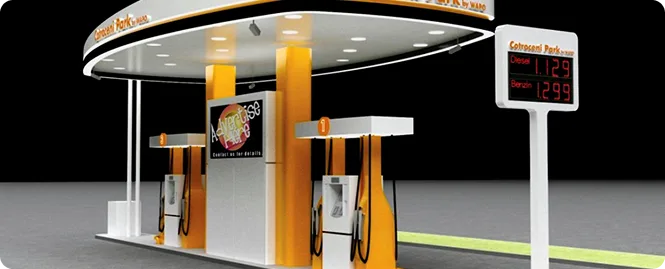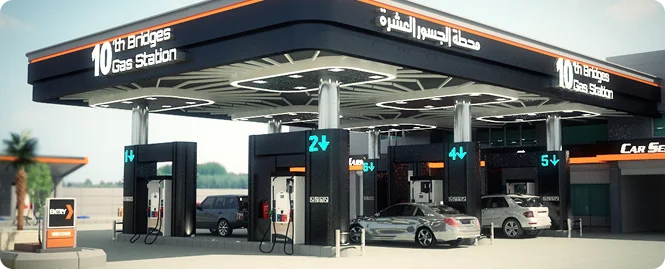How to Open a Gas Station in Georgia
Table of Contents
Key Takeaways
-
Choosing the right location and understanding the local market are crucial for a successful gas station. High-traffic areas with limited competition can significantly impact profitability.
-
A well-structured business plan helps secure funding, estimate startup costs, and outline profit projections. It should cover market analysis, operational strategy, and long-term goals.
-
Gas station owners must obtain the necessary permits and licenses, comply with environmental regulations, and choose the right business structure (LLC, sole proprietorship, etc.) to ensure legal compliance.
-
The right gas pumps, fuel suppliers, and convenience store products impact revenue. Hiring and training skilled employees improves customer service and operational efficiency.
-
A strong marketing strategy, including promotions and loyalty programs, attracts customers. Regular maintenance and adherence to safety regulations ensure smooth, long-term operations.
Georgia’s gas station industry is a promising venture for entrepreneurs who are looking to capitalize on constant fuel demand. Beyond selling gasoline, stations generate revenue through convenience stores, car washes, and additional services. Success depends on factors like location, competition, and pricing strategies. With the right business plan and execution, opening a gas station in Georgia can provide a steady income stream and long-term growth potential in an industry that remains essential to daily life.
Understanding the necessary steps before entering the gas station business is crucial. This includes choosing the right business structure, securing proper financing, and obtaining the required permits, which are just a starting point. Market analysis, site selection, and equipment procurement play vital roles in profitability. Whether you’re a first-time investor or an experienced business owner, proper planning will help ensure a smooth launch for your business and guarantee long-term success in Georgia’s competitive gas station market.
Step 1: Researching the Market and Location
Choosing the right location for a gas station in Georgia isn’t just about planting pumps anywhere with open space—it’s about strategy. High-traffic intersections, highways, and growing suburban areas offer prime real estate. Proximity to residential communities and commercial hubs increases footfall, ensuring steady fuel and convenience store sales. A well-placed station can mean the difference between thriving profits and struggling to attract customers, making location selection one of the most critical steps in the journey.
Before breaking ground, a deep dive into market analysis is a requirment. Find answers to questions such as: Where do drivers refuel the most? Which areas have underserved demand? Understanding traffic flow, peak hours, and nearby competitors helps pinpoint the best location. A station near busy commuter routes or major retail centers has a built-in customer base, while excessive competition in one area can squeeze profit margins. Strategic placement ensures consistent business and long-term sustainability.
Georgia’s residents don’t only focus on the lowest gas prices—convenience, speed, and additional services matter, too. Consumers value easy access, multiple payment options, and well-stocked convenience stores. Some prefer stations with car washes, while others seek locations with quick food options. Identifying these preferences allows business owners to customize their offerings.
Step 2: Creating a Business Plan
A strong business plan is the foundation of a successful gas station in Georgia. It provides the store owner with a clear vision, helping them navigate startup costs, daily operations, and future growth. Investors and lenders want to see a detailed, well-structured plan before funding their venture. From understanding market demand to estimating expenses, a well-thought-out business plan ensures they stay on track, avoid costly mistakes, and set realistic expectations for profitability in this competitive industry.
Your business plan should include essential elements such as financial projections, estimated profit margins, and funding strategies. A thorough market analysis can help define who your target audience and competitors are. Marketing strategies outline how you'll attract customers, while operational details explain staffing needs and equipment requirements. Revenue goals, cost management, and contingency plans should also be included, ensuring that your gas station operates smoothly from day one and remains profitable in the long run.
A business plan is so much more than just opening day—it’s about long-term sustainability. Will you expand into additional locations? Or introduce new revenue streams like a car wash or fast food service? Understanding future trends in fuel consumption and consumer behavior will keep your gas station competitive. Setting milestones for growth, upgrading technology, and adapting to market changes ensure your station remains a profitable investment, positioning it for long-term success in Georgia’s dynamic fuel industry.
Step 3: Legal and Regulatory Requirements
Opening a gas station in Georgia requires obtaining various permits, licenses, and registrations to operate legally. Business owners must register their business structure—whether as a sole proprietorship, LLC, or corporation—secure a federal Employer Identification Number (EIN), and obtain state and local business licenses. Additional permits include fuel storage and sales permits, fire safety inspections, and environmental clearances. Ensuring full compliance from the start prevents legal issues and keeps your gas station running without unexpected roadblocks.
Before cutting the opening day ribbon, you must understand Georgia’s zoning laws and local regulations for gas stations. Certain areas may restrict fuel station construction due to proximity to schools, residential zones, or environmental concerns. Local governments may also have regulations on signage, traffic flow, and operating hours. Conducting a thorough market analysis and consulting with regional authorities can help you choose a location that is legally approved and strategically positioned for maximum profitability.
Gas stations must adhere to strict environmental regulations to prevent contamination and ensure safe fuel storage. This can include obtaining Underground Storage Tank (UST) permits, following guidelines for hazardous material disposal, and meeting air quality standards. Regular inspections are mandatory to prevent leaks, spills, and groundwater contamination. Failure to comply can lead to hefty fines and even business shutdowns. Staying informed on environmental policies ensures your gas station operates safely, sustainably, and without legal complications.

Step 4: Securing Financing
Starting a gas station in Georgia requires a solid financial foundation. Business loans from banks and credit unions, Small Business Administration (SBA) loans, and private investors are familiar funding sources. Some gas station owners explore franchise opportunities or seller financing when purchasing an existing location. Understanding startup costs, profit margins, and ongoing operational expenses helps you determine the best financing strategy. A well-thought-out financial approach ensures your gas station has the capital needed to thrive.
To attract lenders and investors, you need a comprehensive business plan with precise financial projections. This includes an income statement, cash flow forecast, and expense breakdown. Potential financiers want a detailed market analysis, projected revenue, and long-term growth strategies. Organizing financial documents, maintaining a strong credit score, and demonstrating industry expertise will improve your chances of securing funding. A compelling plan reassures investors that your gas station is a profitable venture.
Entrepreneurs in Georgia can explore state and federal programs to support small businesses. The SBA offers loan guarantees, while local economic development agencies provide grants and tax incentives. Some environmental programs fund eco-friendly gas stations, such as energy-efficient fuel pumps or alternative energy solutions. Researching available resources can help reduce initial startup costs and provide financial stability. Taking advantage of these opportunities can give your gas station a competitive edge in the market.
Step 5: Selecting the Right Equipment and Suppliers
Running a gas station can require investing in key equipment in order to ensure smooth operations. Fuel dispensers, underground storage tanks, and point-of-sale (POS) systems are at the core of daily transactions. Safety measures like leak detection systems and fire suppression equipment are also crucial. Choosing durable, efficient equipment minimizes maintenance costs and keeps customers satisfied. Additionally, investing in modern payment options, such as mobile pay and loyalty programs, enhances convenience and boosts customer retention.
Partnering with a trusted fuel supplier can help owners maintain steady commercial operations. Whether working with a major fuel brand or an independent wholesaler, negotiating favorable contracts allows for better pricing and reliable fuel delivery. Understanding fuel price fluctuations and supply chain logistics can help gas station owners secure competitive rates. Additionally, exploring long-term agreements, volume discounts, and flexible payment terms will help improve profit margins while ensuring a consistent fuel supply for your business.
A successful gas station offers so much more than just fuel—convenience stores, car washes, and auto repair services provide additional income streams. Stocking high-demand convenience store items such as snacks, beverages, and automotive essentials helps increase customer spending. Car washes and tire services attract repeat customers while partnering with food franchises can further boost sales. Diversifying revenue sources not only strengthens financial stability but also helps your gas station stand out in a competitive market.
Step 6: Building and Designing the Gas Station
Constructing a gas station calls for careful planning to optimize functionality and customer experience. The layout should allow for easy vehicle flow, strategically placed fuel pumps, and a well-designed convenience store. Selecting durable materials, investing in energy-efficient lighting, and incorporating modern technology improve efficiency and longevity. Additionally, a welcoming exterior with clear signage further enhances brand visibility and attracts more customers. Thoughtful design not only improves operations but also ensures a seamless experience for visitors.
Meeting safety standards and building codes is essential when designing a gas station. Proper fuel storage, fire suppression systems, and emergency protocols help mitigate a range of common risks. Accessibility features, including well-marked parking spaces, wheelchair ramps, and user-friendly payment terminals, create an inclusive customer experience. Compliance with zoning laws, environmental regulations, and local business permits is crucial for avoiding fines and operational disruptions. Prioritizing safety and accessibility builds trust and ensures long-term business success.
A well-designed gas station should be efficient, aesthetically appealing, and customer-friendly. Clear traffic flow, well-lit fueling areas, and organized store shelving encourage easy navigation. Clean restrooms, comfortable seating, and grab-and-go food options enhance the customer experience. A thoughtfully planned layout increases efficiency, maximizes sales opportunities, and keeps customers wanting to return.
Step 7: Hiring and Training Employees
Hiring the right employees is vital for running a successful gas station. Look for individuals who have strong customer service skills, reliability, and attention to detail. Roles can include cashiers, fuel attendants, store managers, and maintenance personnel. Conduct thorough interviews, check references, and offer competitive wages to attract quality candidates. A well-trained team enhances efficiency, improves customer satisfaction, and ensures smooth day-to-day operations. Investing in good employees leads to a more profitable and reputable business.
Proper employee training is crucial in order to maintain high standards in safety, customer service, and daily operations. Staff should be well-versed in handling fuel safely, preventing theft, and assisting customers efficiently. Implement structured training programs that cover emergency protocols, inventory management, and POS system usage. A well-trained team helps minimize risks, enhances service quality, and boosts overall efficiency. Continuous training and refresher courses help employees stay updated on industry standards and improve workplace performance.
Effective employee scheduling ensures smooth operations and prevents understaffing or excessive overtime. Use scheduling software to create shifts, track hours, and manage time-off requests. Implement an efficient payroll system that accurately calculates wages, taxes, and benefits. Automating these processes reduces errors and ensures employees are compensated fairly and on time.
Step 8: Marketing and Promotion
Launching a gas station requires a strong local marketing strategy. Use flyers, banners, and newspaper ads to generate buzz before opening day. Partner with radio stations for promotional mentions and offer limited-time discounts to attract first-time customers. Visibility matters, so clear signage and roadside billboards highlight your station’s competitive fuel prices and convenience store offerings. Engaging with the local community early on can help establish a loyal customer base and boost initial foot traffic.
A strong online presence is likely to drive more customers to your gas station. Leverage social media platforms such as Facebook and Instagram to share special offers, fuel discounts, and seasonal promotions. Implement loyalty programs that reward repeat customers with discounts or free items. Offering bundle deals—like discounts on snacks with a fuel purchase—encourages higher spending. Engaging with customers through digital platforms builds brand awareness and keeps your station top-of-mind for drivers in the area.
Building relationships with local businesses and organizations helps increase brand recognition. Collaborate with nearby restaurants, auto shops, or delivery services for cross-promotions. Sponsoring local events, school fundraisers, or charity drives enhances goodwill and creates positive word-of-mouth. Being actively involved in the community strengthens customer trust and fosters long-term business success.
Step 9: Ongoing Operations and Maintenance
Running a gas station requires efficient day-to-day operations, from managing fuel inventory to stocking shelves with high-demand convenience store items. Fuel pricing should be adjusted based on market trends, supplier costs, and competitor rates to remain competitive. Implementing inventory management software helps track sales patterns, ensuring products are replenished on time while reducing waste. Streamlining operations with a reliable point-of-sale (POS) system and staff training improves efficiency, minimizes errors, and enhances the overall customer experience.
Regular maintenance is crucial for both safety and operational efficiency. Fuel dispensers, storage tanks, and other equipment must be inspected frequently to prevent malfunctions and environmental hazards. Gas stations must comply with safety and environmental regulations, including proper waste disposal and emergency preparedness. Well-lit premises, security cameras, and clear signage enhance customer safety and deter theft. Ensuring a clean and organized facility not only meets regulatory standards but also attracts more customers and improves satisfaction.
Listening to customer feedback helps refine service quality and address operational issues. Encouraging reviews through online platforms or in-store surveys can provide insights into what customers appreciate and where improvements are needed. Offering promotions, loyalty programs, and additional services like car washes or air pumps enhances the overall customer experience.
Conclusion
Opening a gas station in Georgia involves thorough market research, securing financing, obtaining permits, and setting up operations efficiently. Choosing a strategic location, investing in quality equipment, hiring trained staff, and implementing strong marketing strategies are key. Maintaining regulatory compliance, optimizing fuel pricing, and offering additional services ensure long-term profitability.
Insurance protects gas station owners from financial risks, including property damage, employee injuries, and liability claims. Coverage options like general liability, workers' compensation, and environmental insurance protect against unforeseen events. A comprehensive insurance policy helps business owners stay financially secure, comply with legal requirements, and maintain smooth operations during unexpected challenges.









